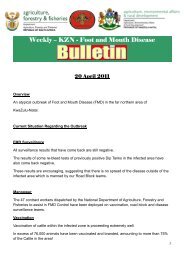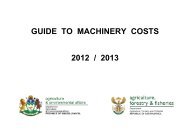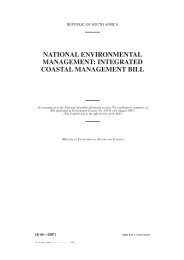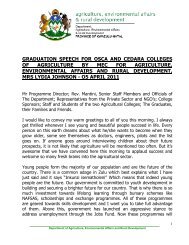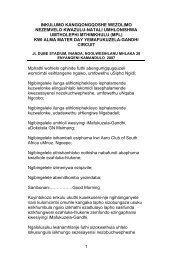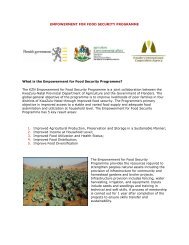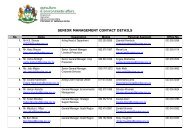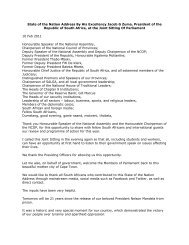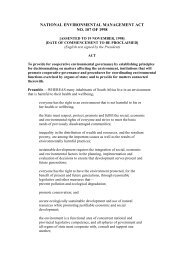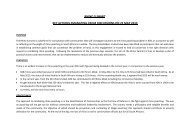Socio-Economic Report - Department of Agriculture and ...
Socio-Economic Report - Department of Agriculture and ...
Socio-Economic Report - Department of Agriculture and ...
Create successful ePaper yourself
Turn your PDF publications into a flip-book with our unique Google optimized e-Paper software.
UDM ENVIRONMENTAL MANAGEMENT FRAMEWORK<br />
The map indicates uneven population density with the main economic nodes having<br />
the highest population density. These areas <strong>of</strong> higher population density include,<br />
Mtubatuba, St Lucia, Hlabisa, Hluhluwe, Mkuze, Ubombo, Jozini <strong>and</strong> Ingwavuma<br />
<strong>and</strong> Manguzi.<br />
Mtubatuba as the largest urban area in the District is also characterised by having<br />
the largest number <strong>of</strong> post <strong>of</strong>fices, a concentration <strong>of</strong> health facilities <strong>and</strong> two policing<br />
stations. Thus infrastructure development is greatest in the largest urbanised area<br />
<strong>and</strong> main town <strong>of</strong> UDM.<br />
HEALTH<br />
Assessing the health st<strong>and</strong>ards <strong>of</strong> the municipality <strong>and</strong> the clinics is important to<br />
underst<strong>and</strong>ing the social <strong>and</strong> living st<strong>and</strong>ards <strong>of</strong> the community. The number <strong>of</strong><br />
hospitals is an indicator <strong>of</strong> health as well as accessibility <strong>and</strong> level <strong>of</strong> municipal<br />
service.<br />
ACCESS TO HEALTHCARE<br />
There are five public hospitals in uMkhanyakude DM. These are supported fifty two<br />
provincial clinics in UDM <strong>and</strong> are mostly visited on a two week basis by medical <strong>and</strong><br />
paramedical staff. There are no specialists in the UDM hospitals (KwaZulu-Natal<br />
<strong>Department</strong> <strong>of</strong> Health, 2001).<br />
MANGUZI HOSPITAL<br />
The Manguzi Hospital is made up <strong>of</strong> ten residential clinics <strong>and</strong> three mobile teams<br />
visiting 35 points. This clinic forms part <strong>of</strong> Umhlabuyalingana Municipality.<br />
The ten residential clinics are:<br />
Bhekabantu Clinic Mahlungulu Clinic Mvelakabusha Clinic Thengani Clinic<br />
Kwa- Zibi Clinic Mboza Clinic Phel<strong>and</strong>aba Clinic Zamazama Clinic<br />
KwaNdaba Clinic<br />
Mshudu Clinic<br />
Listed in order <strong>of</strong> importance, the main causes <strong>of</strong> mortality found in the clinic among<br />
adults are HIV/AIDS, Tuberculosis, Gastroenteritis, Pneumonia, Meningitis, Renal<br />
failure, Cancer <strong>and</strong> Cardiac related deaths (CVA <strong>and</strong> CCF) (KwaZulu-Natal<br />
<strong>Department</strong> <strong>of</strong> Health, 2001).<br />
Disease amongst children include, HIV related deaths, Pneumonia, Stillbirths, TB,<br />
Gastroenteritis, Neonatal deaths, Trauma, Meningitis, Malnutrition <strong>and</strong> Malaria<br />
(KwaZulu-Natal <strong>Department</strong> <strong>of</strong> Health, 2001).<br />
HLABISA HOSPITAL<br />
<strong>Socio</strong>-<strong>Economic</strong> Assessment Page 28



